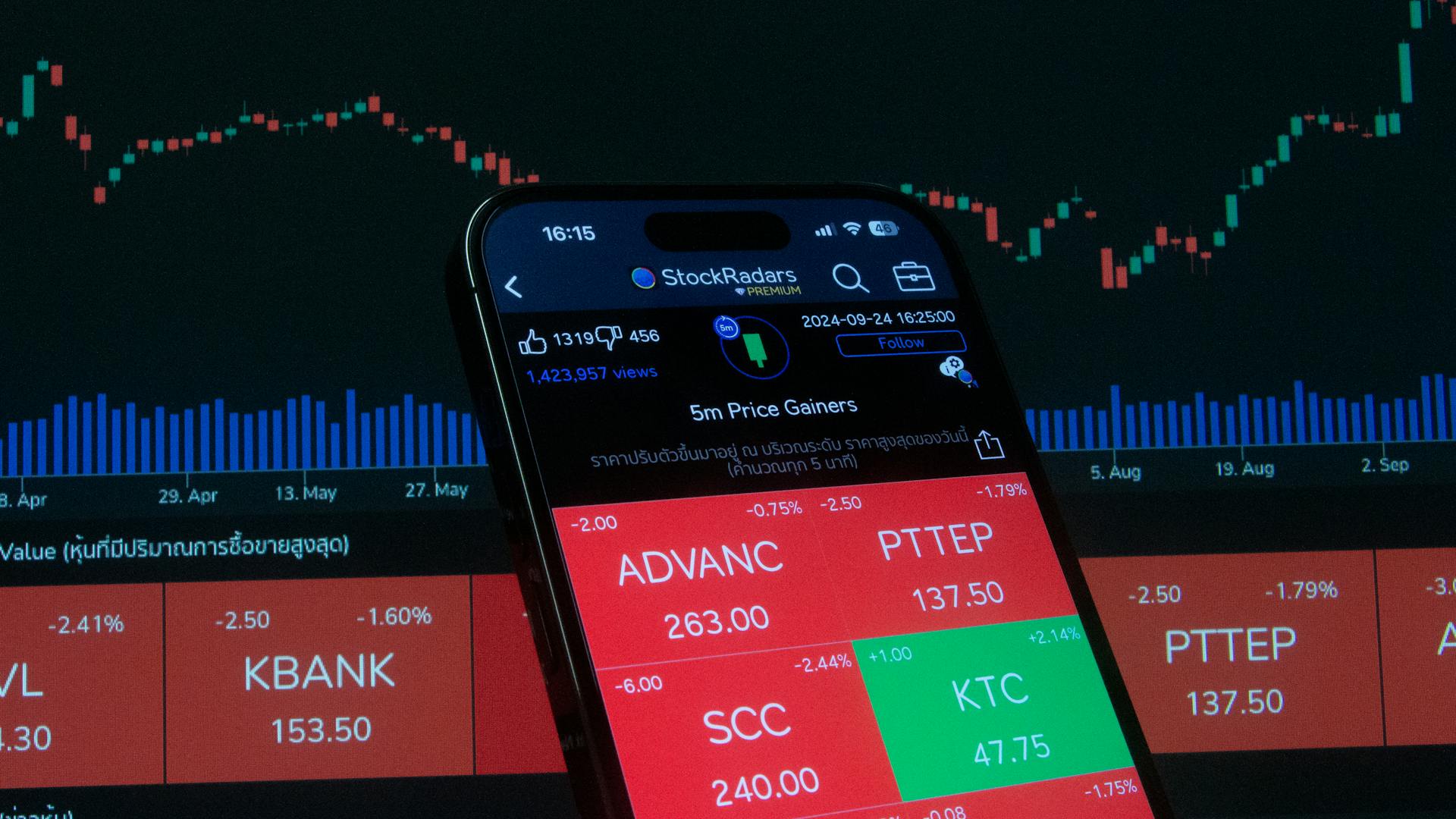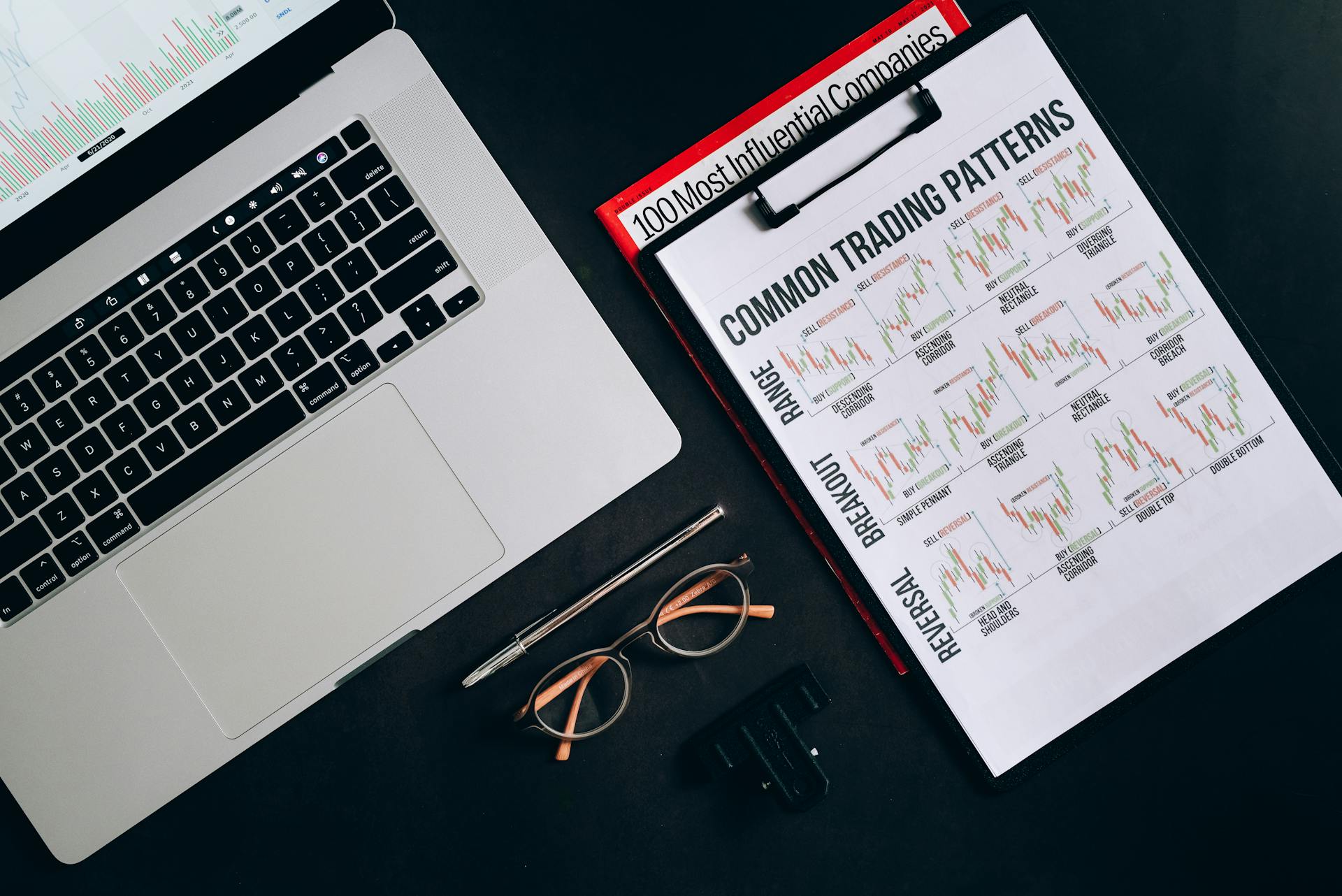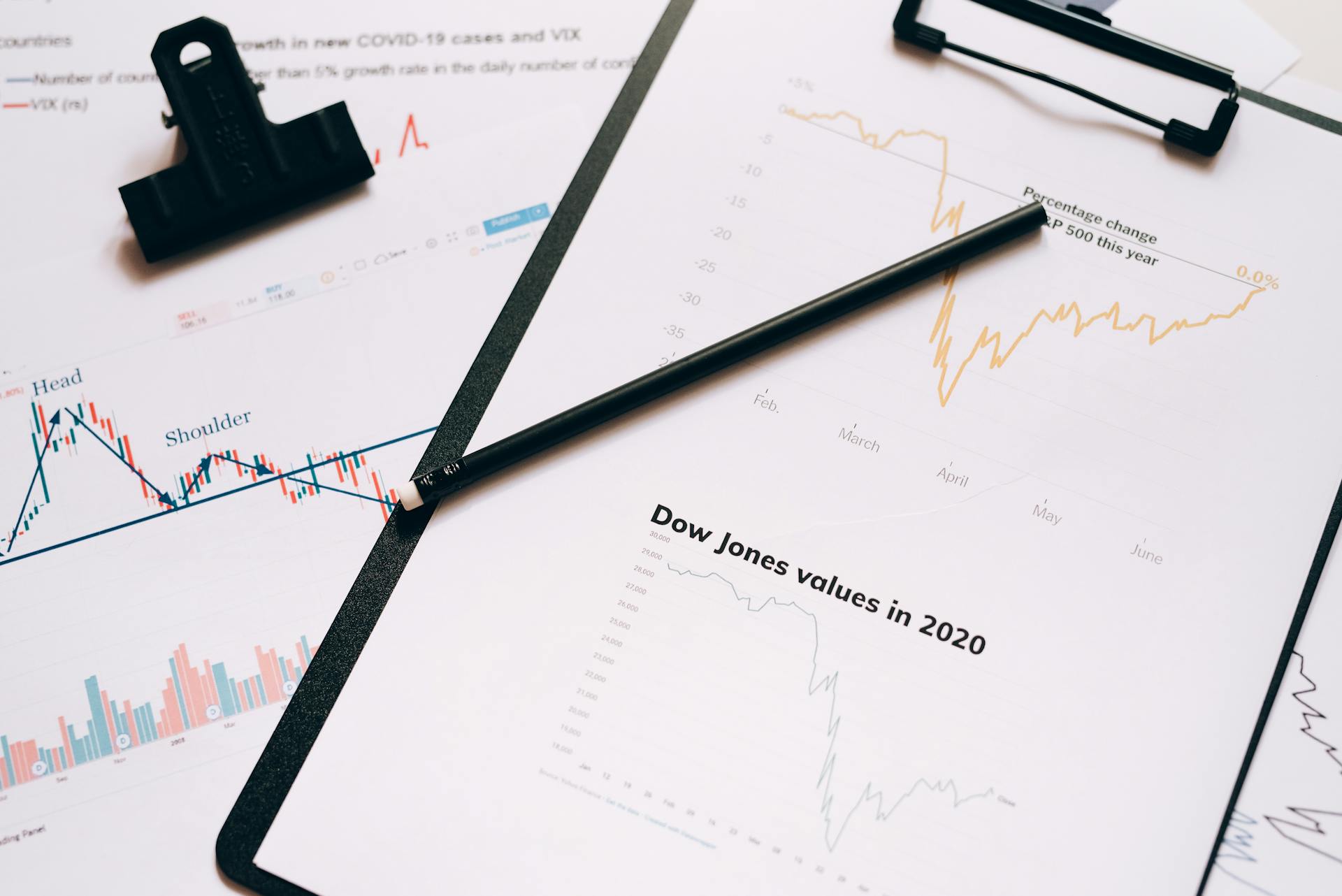
Nicolas Darvas was a professional dancer and stock trader who achieved incredible success with his unique approach to the markets. He made over $2 million in the 1950s, which is equivalent to over $20 million today.
Darvas developed a stock trading method that focused on technical analysis and a specific set of rules to identify winning stocks. This method involved analyzing charts to find stocks with strong uptrends and then buying them when they pulled back.
One of the key principles of Darvas' method was to look for stocks that had broken through a resistance level, indicating a strong uptrend. He believed that these stocks were more likely to continue moving upward.
Darvas' method also emphasized the importance of risk management, as he only invested a small portion of his capital in each trade. This allowed him to minimize his losses and maximize his gains.
Who Is?
Nicolas Darvas was a professional ballroom dancer who had a secret passion for stock trading. He was born in Hungary in 1920.

At the age of 23, Darvas fled to Istanbul to avoid the turmoil of World War II. He later developed a unique stock trading approach that led to his financial success.
Darvas spent up to eight hours a day studying the stock market and speculators, dedicating himself to becoming a self-taught investor. He read over 200 books on the subject in his spare time as a dancer.
His primary source for stock selection was Barron's magazine, a classic stock market text. He successfully traded using cables and telegrams to send orders to his broker despite his touring schedule.
Nicolas Darvas' investment method, known as the "BOX theory", involved waiting for a stock price to break out of a defined "box" range before buying. He would then sell when the price reached a desired profit level.
Darvas earned $2,450,000 in just 18 months during the 1957-58 bull market, making a name for himself in the world of stock trading.
Intriguing read: Stock Market Floor Traders
Trading Method Overview

Nicolas Darvas' trading method is built around the concept of the Darvas Box Theory. This theory involves identifying stocks that have hit new highs and shown a significant surge in volume.
To apply the Darvas Box Theory, you need to look for stocks that have recently reached new highs and have a corresponding increase in trading volume. Once you've identified such stocks, you can create a "box" by marking off the recent peak and trough prices.
A stock is considered to be within a Darvas Box when it ascends past its previous high but subsequently retreats close to this peak level. During a bear market, if there's an upward breach through the upper boundary of this established box, that signals an opportunity to purchase.
Here's a summary of the key steps to apply the Darvas Box Theory:
- Identify stocks that have hit new highs and shown a significant surge in volume.
- Create a "box" by marking off the recent peak and trough prices.
- Purchase the stock when it surpasses the box's upper limit.
- Position the stop-loss order at the level where it had broken out from.
- Continuously engage more shares into the position upon breakouts while elevating the stop-loss orders accordingly.
Nicolas Darvas' approach to trading also emphasizes the importance of discipline and risk management. He used stop-loss orders and buying new highs to manage risk and create pre-defined exit points.

Incorporating elements of fundamental analysis into his decision-making process, Darvas focused on corporations with consistent strong earnings records within sectors anticipated to perform well against market trends.
By adhering to these precise conditions for trading activity, Darvas successfully leveraged favorable price shifts while curtailing losses during downturns in stock prices.
Trading Method Application
Applying the Darvas Box Theory to your trading strategy can be done with ease. Initially, look for stocks that have hit new highs and shown a significant surge in volume, these are prime candidates for applying the Darvas box method.
To apply the Darvas Box Theory, you need to identify stocks that have reached new high prices and have a significant surge in volume. These stocks are prime candidates for applying the Darvas box method.
A stock is considered to be within a Darvas Box when it ascends past its previous high but subsequently retreats close to this peak level. This indicates a consolidation phase with the potential for upward movement.

To create a Darvas Box, you need to delineate the recent peak and trough prices of the stock. This will establish the confines of the box and help you identify potential entry points and stop-loss levels.
Nicolas Darvas primarily traded stocks, and his method includes targeting stocks at their peak prices and creating a 'Darvas Box' by marking off recent price highs and lows to establish entry points and stop-loss levels.
Here are the key steps to follow when applying the Darvas Box Theory:
- Identify stocks that have reached new high prices
- Create a Darvas Box by marking off recent price highs and lows
- Purchase stock when it surpasses the box's upper limit
- Increase your position as additional boxes are surpassed
- Elevate the stop-loss order with each newly formed box
By following these steps and incorporating elements of fundamental analysis, you can increase your chances of successful trading.
Trading Indicators and Analysis
Nicolas Darvas was a master of identifying trading opportunities using technical analysis. He focused on stocks that reached new high prices, which he believed indicated a strong upward trend.
To spot these opportunities, Darvas used his "box theory", which involved creating a box around recent price highs and lows to establish entry points and stop-loss levels. He would purchase stocks when they surged past the upper limit of the box and place a stop-loss order at that same level.

Darvas also considered volume as a critical factor in his trading decisions. He believed that abnormal volume levels in a stock could indicate a genuine market breakout. To confirm this, he would monitor the stock's market behavior and track its price fluctuations along with trading volumes.
Here are the key indicators Darvas looked for in the market:
- Stocks reaching new high prices
- Abnormal volume levels
- Price fluctuations within a "box" of recent highs and lows
By combining these indicators, Darvas was able to make informed trading decisions and achieve significant profits in the stock market.
What Indicators Did He Use?
Nicolas Darvas didn't use traditional indicators in his trading, instead relying on price and volume action.
He emphasized the importance of both price and volume as key signals in his trading strategy, which involved concentrating on stocks making new highs.
His method involved charting lines across recent peaks and troughs to determine entry points and stop-loss parameters, known as Darvas boxes, which highlighted stock momentum.
Darvas also integrated elements of fundamental analysis into his selection process, giving special attention to sectors featuring innovative products and companies demonstrating robust earnings consistently over time.

He sought out companies with consistently strong earnings, especially during times of market volatility or unpredictability.
Darvas' approach uniquely combined technical and fundamental analysis techniques to identify stocks with robust patterns on their charts and sturdy foundational business metrics.
He evaluated both price movements and volume in conjunction with a company's operational health to make more educated decisions in stock trading.
Darvas continuously searched for patterns that suggested lucrative trading prospects, specifically stocks setting new highs.
Volume was another critical factor for Darvas, serving as a significant signpost indicating whether or not a stock was primed for substantial movement.
Technical and Fundamental Analysis
Nicolas Darvas was a master of combining technical and fundamental analysis to make informed trading decisions. He believed that a successful trading system should consider both the technical and fundamental aspects of a stock.
Darvas used fundamental analysis to evaluate a company's financial health and growth potential. He focused on companies with strong earnings records and a history of consistent growth. This approach helped him identify potential winners in the market.
A unique perspective: Security Analysis Portfolio Management

One key aspect of Darvas' technical analysis was the use of the "Darvas box." This involves identifying a stock that has reached a new high price and then retracing back to a lower level. The box is formed by drawing a line between the recent peak and trough prices.
Here are some key characteristics of a Darvas box:
- The stock has reached a new high price
- The stock has retraced back to a lower level
- The box is formed by drawing a line between the recent peak and trough prices
Darvas believed that a stock that breaks out of a Darvas box is likely to continue moving upward. He would buy the stock and place a stop-loss order at the level where it broke out.
By combining technical and fundamental analysis, Darvas was able to make more informed trading decisions. His approach was not limited to any single timeframe, and he could adapt it to suit his individual trading needs.
In the end, Darvas' success in the market came down to his ability to combine technical and fundamental analysis with discipline and patience. He was able to turn his initial struggles into a remarkable financial success story.
Suggestion: Investment Portfolio Analysis
Discipline

Discipline is a crucial aspect of Nicolas Darvas' trading strategy. He maintained strict discipline to manage his emotions and prevent external influences from affecting his trading decisions.
To achieve this, Darvas stopped visiting brokerage firms and made a rule against engaging with brokers. He opted instead to execute all his trades via telegram, creating a buffer between himself and the bustling activity of Wall Street.
This approach allowed him to remain impartial in his trading strategy, showing neither excessive affection for his investments during their increase in value nor bitterness during their depreciation.
Darvas' disciplined mentality also enabled him to apply his chosen trading strategies systematically, keep unwavering attention on following his planned course of action, control emotional reactions during periods of market volatility, and adjust appropriately as different conditions presented themselves within the marketplace.
To maintain discipline, Darvas followed a strict set of guidelines, including:
- Applying his chosen trading strategies systematically
- Keeping unwavering attention on following his planned course of action
- Controlling emotional reactions during periods of market volatility
- Adjusting appropriately as different conditions presented themselves within the marketplace
By adhering to these principles, Darvas was able to navigate the market with confidence and make informed trading decisions.
p.article.sections.frequentlyAskedQuestions
What is Darvas box theory?
Darvas box theory is a trading strategy that identifies stocks making new highs and sells them when they decline from these peaks. It uses price and volume indicators to define "boxes" for entry and exit points.
How did I make $2 million in the stock market summary?
The book shares the author's journey from novice trader to market expert, offering timeless wisdom and basic strategies for investing and stock analysis. By following his approach, you can gain the knowledge and skills needed to achieve significant returns, including a $2 million profit.
How I made 2000000 in the stock market summary?
Nicolas Darvas' book "How I Made $2,000,000 In The Stock Market" shares his journey from dancer to successful trader, detailing his unique Darvas Box method and valuable insights. Discover his approach to stock trading and learn from his experiences in this classic investing book.
p.article.sections.sources
p.article.featuredImages pexels.com



